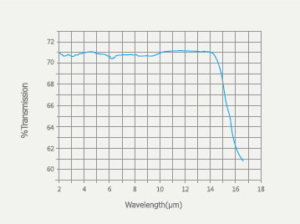ZnSe / Zinc Selenide optical component : a complete guide
If you are working with CO2 lasers impossible to miss the bright amber windows and lenses made of ZnSe. Other very common applications are infrared imaging and biomedical applications. ZnSe is a Semi-conductor material of group II-VI.

Zinc Selenide aspherial lens
Why is ZnSe / Zinc Selenide a good optical material ?
ZnSe has good transmission in IR up to 21µm and therefore is a good choice of material for thermal vision, moreover as it is partially transparent in the visible it is rather easy to do optical alignment.
One of the advantage of ZnSe compared to other IR material is it’s low absorption in the IR, which means it is a very interesting material* for high power lasers and therefore is commonly used for CO2 laser applications at 10,6µm. Furthemore as ZnSe is made by Chemical Vapor Deposition (CVD) its purity is high, therefore no impurity may impact its optical performances.
Zinc Selenide is a good alternative to Germanium for high temperature applications, it can withstand up to 250°C while Germanium optical properties will deteriorate from 100°C.
*absorption would create heat and therefore damage the optics, high absorption material have low LIDT.
ZnSe / Zinc Selenide : properties
Properties chart of Zinc Selenide :
| Property | Values |
|---|---|
| Material name | Zinc Selenide |
| Chemical formula / Chemical element | ZnSe |
| Material structure | Polycrystaline, cubic structure |
| Color | Yellow |
| Index of Refraction | 2.5 (2.403 @ 10.6µm) |
| Transmission range | 600nm to 21µm |
| Density | 5.27 g/cm3 |
| Hardness | 120 Knoop |
| Young’s modulus | 71 GPa |
| Thermal expansion | 7*10-6 °K-1 |
| Thermal conductivity | 19 W/(m*°K) |
| Melting point | 1790 °K |
Transmission curve of Zinc Selenide

Transmission curve of ZnSe
What type of optical component can be made in ZnSe ?
Zinc Selenide is a rather soft material so it is relatively easy to machine and polish it or to diamond turn it, therefore it is directly used for most of the common optical components :
- ZnSe windows : mostly used in Infrared applications and C02 lasers (10.6µm)
- ZnSe lenses : spherical lenses and aspherical ZnSe lenses are often used in IR vision systems.
- ZnSe prisms : used in spectroscopy
Zinc Selenide doesn’t resist to acids and emits toxic gaz when in contact with acids, therefore we don’t recommend its usage for non acid free environments.
HANDLE WITH CARE ! Attention should be give when handling ZnSe optics, they are rather soft and can easily being scratched or damage, moreover the material is toxic, it is recommended to handle it with gloves, and wash hands after handling.
General specifications for windows and lenses
| Properties | Values |
|---|---|
| Available dimensions | Diam 3 to D300mm |
| Dimensional tolerances | +/-0.01mm |
| Surface quality | S&D : 20/10 |
| Flatness | 1/2 lambda |
| Coatings | AR 10.6µm or AR 8-14µm |
Above value are generic specifications for fabrication, specific better value may be available and need to be reviewed case by case.
Where to buy Zinc Selenide optical component ?
ZnSe substrate are very rare naturally and therefore most of the raw material is crystal grown in laboratories.
IR precision optics suppliers provide all kind of Zinc Selenide optical components and can also offer optical coatings for enhanced characteristics.
Don’t hesitate to contact SINOPTIX for more details or request for quotation.







